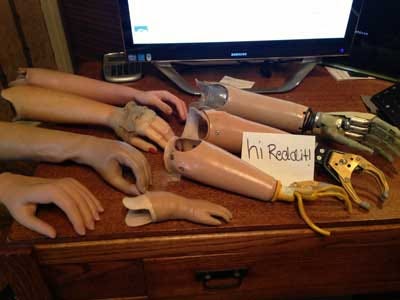Young Amputee Highlights Advances in Prosthetics on Reddit
August 26, 2013
A post on social media website Reddit, which bills itself as "the front page of the Internet," provides an overview of how fast the field of prosthetics is advancing. In the thread, a girl whose screen-name is Angel, shares a picture where she operates a bow and arrow with a prosthetic arm. A congenital amputee, Angel also features a picture of one of the 20 plus prostheses she's worn throughout her life.
The arm (shown below) has two electrodes located within the socket of the prosthesis, triggering the arm to open and close when certain muscles are flexed. In the thread, Angel also provides information on the DARPA's DEKA arm, which, as she puts it, "has feet IMU's (Inertial measurement units) [that] can tell when I hold my feet in different positions (toe up or toe down). This controls the different grips I can put the hand in (left foot IMU), as well as the movement of the wrist (right foot IMU)."
|
A girl with a screen-name of Angel is shown on Reddit holding a bow. Speaking of the arm, she says the arm is experimental but "truly is the best arm [she has] ever worn." |
When Angel was six weeks old, she was fitted with her first passive arm. When she was approximately four months old, she received her first myoelectric prosthesis, which would make her one of the youngest people to be fit with a such a device.
Angel recounts how effective the devices' socket and suction are in keeping the prothetic arms attached:
The socket fits relatively tightly but mostly I use suction. I've done it since I was very young so I don't know entirely how to explain it but I do know that in the 4th grade this boy swung me around by arm trying to get it off and it almost dislocated my shoulder Eventually I had to release suction. He's the only person to ever pull my arm off but technically I don't think that counts.
|
Angel shares a picture of eight of the 20-plus arms she's worn in her lifetime. |
Prosthetic limbs vary greatly in terms of design. A cosmetic prosthetic limb, also known as a cosmesis, is usually designed for aesthetics and appearance. Through the use of color-matched pigments and advanced plastics, these prostheses can appear very close to a real limb (for instance, as this images shows). Artists even add details like hair, freckles and more to this class of prostheses.
In other cases, prosthetic limbs are designed for usability. For example, a pincer-like split hoot is a common controllable prosthetic arm. With a split hook that can be opened or closed, a person can grip objects and perform other tasks.
Some prosthetic limbs are controlled by cables that are connected to other parts of a person's body. For example, some prosthetic limbs can be controlled by a specialized cable attached to a person's healthy, opposite shoulder. By moving this shoulder in certain ways, a person can control their prosthetic limb.
Another class of prosthetic limbs use external power sources like electric motors. Amputees can control these limbs in a variety of different ways. For example, these devices may use inputs like switches, buttons, straps and more. Since these types of devices can perform many different motions, complex switch toggling may be necessary to perform certain tasks.
Some of the most advanced implants receive input from remaining muscles in an amputee's residual limb. Since these muscles generate a low-energy electrical signal, electrodes placed on a person's skin can measure these signals. Based on this, a prosthetic limb can be designed to respond to a person's natural body movements. These prostheses are known as myoelectric.
In her social media post and reader responses, Angel mentions that she is receiving a myoelectric prothesis manufactured by Deka Research. Deka's prostheses technology is being developed with assistance from DARPA, the government. Developed by inventor Dean Kamen, the Deka arm can enable the wearer to perform precise mechanical actions. The Gen 3 Deka arm is streamlined and light. It features an onboard computer.
The rapid pace of development in the field is quickly making possible the scenario that amputees could be "super enabed" rather than disabled, as double-amputee and athlete Aimee Mullins has put it. That may already be happening. In 2012, Sports Illustrated ran an article titled "Does Oscar Pistorius have an unfair advantage?", asking whether it was a good idea to pit him against able-bodied athletes. As the article explained, experts remain split on the answer.
As of August 26, Angel is still answering reader questions on Reddit.com.
For More on Prosthetics, Check Out:
About the Author(s)
You May Also Like



.png?width=300&auto=webp&quality=80&disable=upscale)
